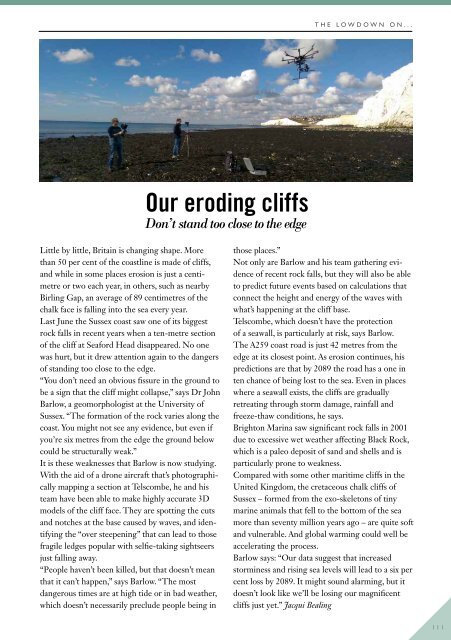Viva Lewes Issue #134 November 2017
Create successful ePaper yourself
Turn your PDF publications into a flip-book with our unique Google optimized e-Paper software.
THE LOWDOWN ON...<br />
Our eroding cliffs<br />
Don’t stand too close to the edge<br />
Little by little, Britain is changing shape. More<br />
than 50 per cent of the coastline is made of cliffs,<br />
and while in some places erosion is just a centimetre<br />
or two each year, in others, such as nearby<br />
Birling Gap, an average of 89 centimetres of the<br />
chalk face is falling into the sea every year.<br />
Last June the Sussex coast saw one of its biggest<br />
rock falls in recent years when a ten-metre section<br />
of the cliff at Seaford Head disappeared. No one<br />
was hurt, but it drew attention again to the dangers<br />
of standing too close to the edge.<br />
“You don’t need an obvious fissure in the ground to<br />
be a sign that the cliff might collapse,” says Dr John<br />
Barlow, a geomorphologist at the University of<br />
Sussex. “The formation of the rock varies along the<br />
coast. You might not see any evidence, but even if<br />
you’re six metres from the edge the ground below<br />
could be structurally weak.”<br />
It is these weaknesses that Barlow is now studying.<br />
With the aid of a drone aircraft that’s photographically<br />
mapping a section at Telscombe, he and his<br />
team have been able to make highly accurate 3D<br />
models of the cliff face. They are spotting the cuts<br />
and notches at the base caused by waves, and identifying<br />
the “over steepening” that can lead to those<br />
fragile ledges popular with selfie-taking sightseers<br />
just falling away.<br />
“People haven’t been killed, but that doesn’t mean<br />
that it can’t happen,” says Barlow. “The most<br />
dangerous times are at high tide or in bad weather,<br />
which doesn’t necessarily preclude people being in<br />
those places.”<br />
Not only are Barlow and his team gathering evidence<br />
of recent rock falls, but they will also be able<br />
to predict future events based on calculations that<br />
connect the height and energy of the waves with<br />
what’s happening at the cliff base.<br />
Telscombe, which doesn’t have the protection<br />
of a seawall, is particularly at risk, says Barlow.<br />
The A259 coast road is just 42 metres from the<br />
edge at its closest point. As erosion continues, his<br />
predictions are that by 2089 the road has a one in<br />
ten chance of being lost to the sea. Even in places<br />
where a seawall exists, the cliffs are gradually<br />
retreating through storm damage, rainfall and<br />
freeze-thaw conditions, he says.<br />
Brighton Marina saw significant rock falls in 2001<br />
due to excessive wet weather affecting Black Rock,<br />
which is a paleo deposit of sand and shells and is<br />
particularly prone to weakness.<br />
Compared with some other maritime cliffs in the<br />
United Kingdom, the cretaceous chalk cliffs of<br />
Sussex – formed from the exo-skeletons of tiny<br />
marine animals that fell to the bottom of the sea<br />
more than seventy million years ago – are quite soft<br />
and vulnerable. And global warming could well be<br />
accelerating the process.<br />
Barlow says: “Our data suggest that increased<br />
storminess and rising sea levels will lead to a six per<br />
cent loss by 2089. It might sound alarming, but it<br />
doesn’t look like we’ll be losing our magnificent<br />
cliffs just yet.” Jacqui Bealing<br />
111


















